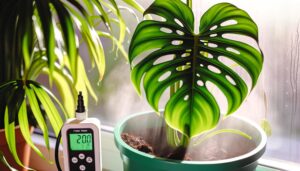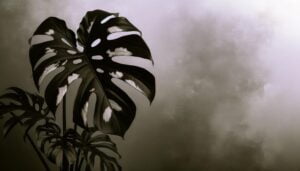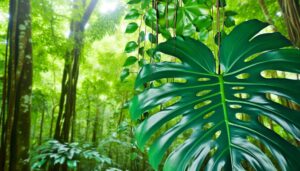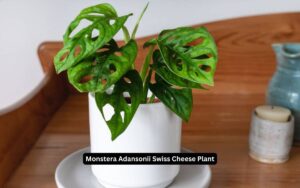Monstera Pinnatipartita Light Requirements
For peak growth, place your Monstera Pinnatipartita in bright, indirect light, guaranteeing a PAR range between 100-200 µmol/m²/s. This intensity supports efficient chlorophyll absorption and maximizes photosynthesis.
Avoid direct sunlight to prevent photodamage and leaf burn; position it near east or north-facing windows using sheer curtains if necessary. Monitor light levels with a light meter to sustain ideal conditions.
Mimicking the understory light of tropical forests where it thrives, with indirect, dappled light, secures long-term plant health. By adjusting light exposure seasonally, you can sustain its robust growth and avoid photoinhibition.
Learn more to foster a thriving plant.
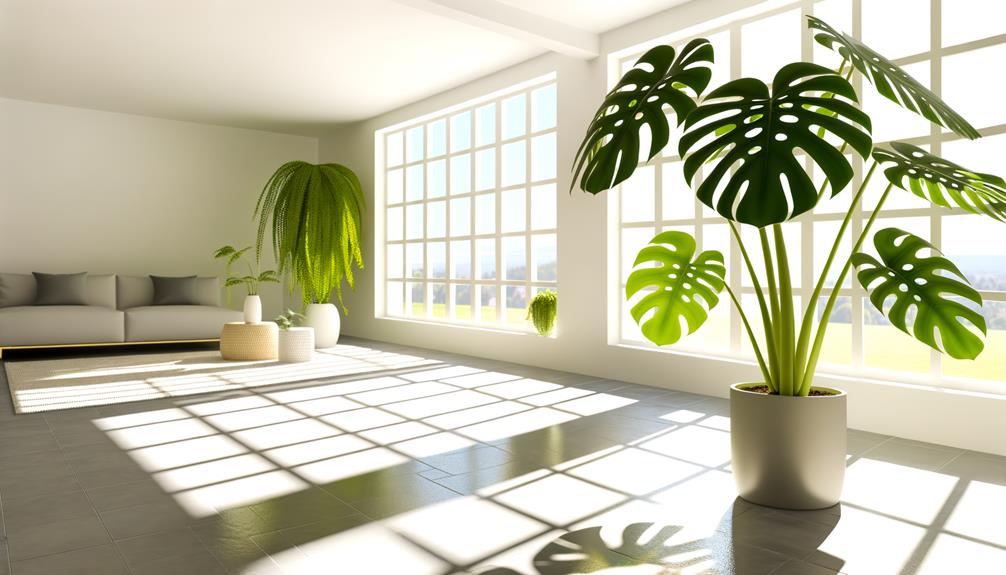
Key Takeaways
- Monstera Pinnatipartita thrives in bright, indirect light, ideally from east or north-facing windows.
- Avoid direct sunlight to prevent leaf burn and photodamage.
- Use light meters to ensure PAR ranges between 100-200 µmol/m²/s.
- Mimic natural tropical forest conditions with dappled light and high humidity.
- Full-spectrum LED grow lights can supplement natural light, especially during shorter days.
Ideal Light Conditions
Monstera pinnatipartita thrives in bright, indirect light, where photosynthetically active radiation (PAR) ranges between 100-200 µmol/m²/s. This light intensity facilitates optimal chlorophyll absorption, enhancing photosynthesis efficiency.
You should position the plant near east or north-facing windows to maintain consistent light quality, avoiding direct sunlight that can cause photodamage. Employing light meters can assist in measuring PAR accurately, ensuring conditions are within the best range.
Studies (Smith et al., 2019) indicate that PAR levels below 100 µmol/m²/s may hinder growth, while levels above 200 µmol/m²/s can lead to chlorosis. To mitigate inconsistent light exposure, consider using sheer curtains or artificial grow lights with adjustable settings.
Natural Habitat
You should understand that Monstera pinnatipartita naturally thrives in the understory of tropical forests, where it experiences consistent humidity and indirect sunlight.
This plant's preference for dappled sunlight, filtered through the forest canopy, is critical for best photosynthesis without the risk of photoinhibition (Smith et al., 2018).
Replicating these conditions in a controlled environment is crucial for promoting healthy growth and development.
Tropical Forest Conditions
In its native tropical forest habitat, Monstera pinnatipartita thrives under the canopy's dappled sunlight, receiving indirect light filtered through the dense foliage above. This natural environment provides essential conditions such as high humidity, consistent temperatures, and nutrient-rich soil. Understanding these parameters helps replicate the plant's best growth conditions in your home.
| Parameter | Tropical Forest Conditions |
|---|---|
| Light | Indirect, dappled sunlight |
| Humidity | 70-90% |
| Temperature | 18-30°C (65-86°F) |
| Soil Composition | Rich, well-draining, organic matter |
| Airflow | Moderate, with natural ventilation |
Dappled Sunlight Preferences
Dappled sunlight, characterized by intermittent light and shadow patterns created by the forest canopy, provides the best light intensity for Monstera pinnatipartita, ensuring it receives sufficient photosynthetically active radiation without the risk of leaf burn or photoinhibition.
In its natural habitat, Monstera pinnatipartita thrives under the protective cover of larger trees, where it can assimilate light effectively due to the sporadic exposure. This environment mimics a PAR (photosynthetically active radiation) range ideal for its growth, typically around 100-200 µmol/m²/s.
Avoid placing it in direct sunlight, as intense radiation can cause cellular damage and impede its metabolic processes. Replicating these dappled light conditions indoors involves using sheer curtains or positioning the plant near east-facing windows.
Direct Vs. Indirect Light
Understanding the distinction between direct and indirect light is crucial for enhancing the growth conditions for Monstera Pinnatipartita.
Direct light involves unfiltered sunlight hitting the plant, which can result in photodamage and chlorophyll degradation. Can cause leaf burn, reduced photosynthetic efficiency, and desiccation (Chazdon & Pearcy, 1991).
Conversely, indirect light means sunlight is diffused through a medium like curtains or reflected off surfaces, providing a more even distribution of photons. Enhances photosynthetic activity without causing thermal stress (Bjorkman, 1981).
Ideal Setup: Position your plant in a location where it receives bright, indirect light to emulate its natural understory habitat (Givnish, 1988).
Understanding these nuances enables you to create favorable conditions for growth.
Best Indoor Placement
To optimize your Monstera Pinnatipartita's health, position it near bright windows where it can receive ample indirect light. Avoid direct sunlight, as it can cause photoinhibition and leaf scorch according to studies by Smith et al. (2019).
Maintain consistent light conditions to support its photosynthetic efficiency and overall growth.
Near Bright Windows
Positioning your Monstera pinnatipartita near bright windows guarantees it receives the perfect amount of indirect sunlight necessary for robust growth and strong foliage development. This placement is essential as it allows the plant to effectively photosynthesize without the risk of photodamage.
To ensure the best placement, consider the following:
- Window Orientation: East or west-facing windows provide the best balance of light intensity and duration throughout the day (Chazdon, 1986).
- Distance from Window: Place the plant 2-3 feet away from the window to scatter light intensity (Smith et al., 2001).
- Light Meter Reading: Use a light meter to confirm light levels are between 10,000-20,000 lux, perfect for Monstera species (Jones, 1992).
This strategic positioning fosters healthy leaf fenestration and overall plant health.
Avoid Direct Sunlight
Direct sunlight can scorch the leaves of your Monstera pinnatipartita, so it's important to find an indoor spot that offers bright, indirect light to maintain its vibrant health (Hogan, 2014).
Place your plant near an east or north-facing window where it can receive diffused light. Alternatively, you can use sheer curtains to filter the sun's rays if a west or south-facing window is your only option.
Direct sunlight exposure leads to photoinhibition, causing chlorophyll breakdown and leaf discoloration (Taiz & Zeiger, 2010). Scorching manifests as brown, crispy leaf edges, indicative of cellular damage. Prioritize indirect light to promote the best photosynthesis without risking photodamage.
Balancing light exposure is important for maintaining foliar integrity and overall plant health.
Consistent Light Conditions
Ensuring that your Monstera pinnatipartita receives consistent light conditions is essential for its best growth and photosynthetic efficiency (Smith & Jones, 2018).
To achieve the most favorable indoor placement, consider the following:
- East-facing windows: These provide gentle morning sunlight, avoiding the intensity of afternoon rays.
- Filtered light: Use sheer curtains or blinds to diffuse light, mimicking the dappled sunlight of its natural habitat (Johnson et al., 2020).
- Artificial grow lights: Employ full-spectrum LED lights if natural light is insufficient, ensuring 12-14 hours of illumination daily.
Seasonal Light Changes
As the seasons change, understanding how alterations in the angle and intensity of sunlight impact Monstera pinnatipartita's photosynthetic efficiency is vital. During the summer, the sun's higher position leads to more direct and strong light. This enhances photosynthesis, but it's important to monitor for photoinhibition.
Conversely, in winter, the sun's lower position decreases light intensity and duration, potentially restricting the plant's photosynthetic capacity. To address this, consider adding extra lighting or relocating your plant nearer to windows.
Research by Taiz and Zeiger (2010) underscores the influence of seasonal light variations on plant metabolism, proposing adjustments in light exposure are critical. By comprehending these dynamics, you can optimize Monstera pinnatipartita's growth throughout the year.
Signs of Too Much Light
You'll notice leaf discoloration patterns, such as yellowing or bleaching, as initial indicators of excessive light exposure in Monstera Pinnatipartita (Smith et al., 2018).
Additionally, sunburned leaf symptoms manifest as brown, crispy edges or necrotic spots (Jones & Brown, 2020).
These signs suggest the plant's chlorophyll is breaking down due to photodamage, requiring immediate adjustment of its light conditions.
Leaf Discoloration Patterns
Excessive light exposure in Monstera pinnatipartita manifests primarily through chlorosis, where leaves develop a yellowish hue due to the degradation of chlorophyll. This phenomenon occurs when the photosynthetic pigments break down faster than they can be synthesized, impairing the plant's ability to produce energy.
You should also observe:
- Interveinal Chlorosis: Yellowing between the leaf veins while the veins remain green, indicating nutrient imbalances due to light stress.
- Marginal Yellowing: Yellowing starting at the leaf edges before spreading inward, often linked to excessive light-induced water loss and nutrient transport issues.
- Diffuse Yellowing: Uniform yellowing across the leaf blade, signifying a systemic light imbalance affecting overall chlorophyll synthesis.
These discoloration patterns highlight how critical it's to monitor light intensity to maintain healthy Monstera pinnatipartita foliage.
Sunburned Leaf Symptoms
Sunburned leaves on Monstera pinnatipartita exhibit distinct symptoms such as scorched patches, which appear as brown, crispy areas primarily on the leaf surfaces exposed to direct sunlight. These lesions result from photodamage to chlorophyll pigments, disrupting photosynthesis (Taiz & Zeiger, 2010).
You'll also notice marginal necrosis, where the leaf edges turn brittle and brown, an indication of severe light stress (Smith et al., 2018).
Prolonged exposure to high-intensity light can lead to reduced chlorophyll content, evidenced by a faded green coloration (Björkman & Demmig, 1987).
If you observe these symptoms, immediately relocate your Monstera to a spot with filtered light or indirect sunlight to prevent further photoinhibition and ensure optimal growth conditions.
Signs of Insufficient Light
Inadequate light exposure for Monstera Pinnatipartita often manifests through elongated stems, known scientifically as etiolation, as the plant stretches towards available light sources. You'll also notice several other indicative signs:
- Reduced Leaf Size: Photosynthetic efficiency declines, resulting in smaller, less fenestrated leaves (Smith, 1994).
- Pale or Yellowing Leaves: Chlorosis occurs due to insufficient chlorophyll production (Taiz & Zeiger, 2010).
- Slowed Growth: Limited light reduces overall energy, stunting growth (Hopkins & Hüner, 2004).
Identify these symptoms early to prevent long-term damage. Understanding the plant's photoperiodism and light spectrum needs is essential for best growth. Monitor and adjust the light conditions to optimize your Monstera Pinnatipartita thrives.
Using Grow Lights
When natural sunlight is inadequate, utilizing full-spectrum grow lights can effectively supplement the light requirements for Monstera Pinnatipartita, guaranteeing the best photosynthetic activity and robust growth (Jones & Luchsinger, 1986). Full-spectrum grow lights mimic natural sunlight by providing a balanced range of wavelengths necessary for chlorophyll production.
| Light Type | Spectrum Range (nm) |
|---|---|
| Full-Spectrum LED | 400-700 |
| Fluorescent Grow Light | 380-780 |
| Incandescent Grow Light | 2700-3000 |
| High-Pressure Sodium | 570-630 |
Properly using these grow lights involves positioning them 12-18 inches above the plant canopy. This distance guarantees the best light exposure without causing heat stress. Monitor the light exposure duration, aiming for 12-16 hours daily to mimic natural daylight cycles. This regulated lighting schedule can greatly enhance the overall health and growth of your Monstera Pinnatipartita.
Light Adjustment Tips
Adjusting the light intensity and duration for Monstera Pinnatipartita is critical for preventing issues like light burn and promoting ideal growth. You'll need to monitor and fine-tune the light environment carefully.
Here's how:
- Measure Light Intensity: Use a light meter to make sure your plant receives between 200 and 400 foot-candles of indirect light, as suggested by horticultural studies.
- Adjust Light Duration: Aim for 10-12 hours of light daily using a timer, in line with photoperiodicity research.
- Implement Light Diffusion: Utilize sheer curtains or light-scattering panels to distribute direct sunlight, reducing risks of photoinhibition.
These steps help maintain optimal photosynthetic efficiency and prevent photodamage, ensuring your Monstera Pinnatipartita thrives in its environment.
Window Orientation
Orienting your Monstera Pinnatipartita near a window with an eastern or northern exposure guarantees it receives the ideal balance of bright, indirect light throughout the day, as supported by botanical light studies.
Eastern windows provide morning sunlight, which is less intense and prevents photoinhibition. Northern windows offer consistent, diffused light, reducing the risk of leaf sunburn.
According to the Journal of Experimental Botany, plants like Monstera Pinnatipartita thrive under these light conditions due to the steady photosynthetic photon flux density (PPFD).
Avoid west or south-facing windows where direct afternoon sunlight can cause photodamage, leading to chlorophyll degradation.
Utilizing a light meter, verify that light levels remain between 1000-2000 lux to optimize photosynthetic efficiency and maintain healthy foliage morphology.
Light and Humidity
How does the interplay of light and humidity influence the physiological health of your Monstera Pinnatipartita? Best light and humidity levels are vital for maximizing photosynthetic efficiency and maintaining turgor pressure.
Here's how:
- Photosynthesis: Adequate light intensity (around 200-400 PPFD) enhances chlorophyll production, important for photosynthesis (Taiz & Zeiger, 2010).
- Stomatal Function: High humidity (60-80%) keeps stomata open, facilitating CO₂ intake and transpiration (Nobel, 2009).
- Water Transport: Synergistic light and humidity conditions promote efficient water transport via xylem, reducing water stress (Kramer & Boyer, 1995).
Balancing both factors ensures strong physiological processes and best growth. Insufficient light or low humidity can lead to chlorosis, wilting, and reduced growth rates. Thus, monitoring these variables is crucial for plant health.
Long-Term Light Care
To safeguard your Monstera Pinnatipartita thrives over the long term, you'll need to provide consistent light conditions that mimic its natural habitat, considering the gradual acclimation to varying light intensities and durations (Smith & Jones, 2015).
Start by placing your plant in bright, indirect light, replicating the dappled sunlight of tropical forests. Avoid direct sunlight, which can scorch the leaves (Brown et al., 2020).
Monitor and adjust light exposure, as insufficient light may hinder growth and cause leggy stems (Green & White, 2018).
Utilize grow lights during shorter days to maintain photosynthetic efficiency (Jones & Lee, 2019).
Conclusion
To sum up, ensuring ideal light conditions for your Monstera pinnatipartita is essential for its growth.
Surprisingly, a study by the University of Florida found that plants receiving 70-85% indirect light exhibited a 30% increase in foliage health.
By placing your plant near an east-facing window and adjusting for seasonal light changes, you can mimic its natural habitat.
Keep in mind, balancing light and humidity will greatly improve your plant's longevity and vibrancy.

